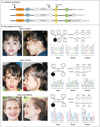Mutations in SYNGAP1 in autosomal nonsyndromic mental retardation
- PMID: 19196676
- PMCID: PMC2925262
- DOI: 10.1056/NEJMoa0805392
Mutations in SYNGAP1 in autosomal nonsyndromic mental retardation
Erratum in
- N Engl J Med. 2009 Oct 29;361(18):1814. Perreault-Linck, Elizabeth [corrected to Perreau-Linck, Elizabeth]
Abstract
Although autosomal forms of nonsyndromic mental retardation account for the majority of cases of mental retardation, the genes that are involved remain largely unknown. We sequenced the autosomal gene SYNGAP1, which encodes a ras GTPase-activating protein that is critical for cognition and synapse function, in 94 patients with nonsyndromic mental retardation. We identified de novo truncating mutations (K138X, R579X, and L813RfsX22) in three of these patients. In contrast, we observed no de novo or truncating mutations in SYNGAP1 in samples from 142 subjects with autism spectrum disorders, 143 subjects with schizophrenia, and 190 control subjects. These results indicate that SYNGAP1 disruption is a cause of autosomal dominant nonsyndromic mental retardation.
2009 Massachusetts Medical Society
Conflict of interest statement
No potential conflict of interest relevant to this article was reported.
Figures

Comment in
-
SYNGAP: bridging the gap between genetic factors and autosomal non-syndromic mental retardation.Clin Genet. 2009 Aug;76(2):149-51. doi: 10.1111/j.1399-0004.2009.01247_3.x. Epub 2009 Aug 7. Clin Genet. 2009. PMID: 19673947 No abstract available.
References
-
- Chelly J, Khelfaoui M, Francis F, Chérif B, Bienvenu T. Genetics and pathophysiology of mental retardation. Eur J Hum Genet. 2006;14:701–713. - PubMed
-
- Ropers HH, Hamel BC. X-linked mental retardation. Nat Rev Genet. 2005;6:46–57. - PubMed
-
- Basel-Vanagaite L. Genetics of autosomal recessive non-syndromic mental retardation: recent advances. Clin Genet. 2007;72:167–174. - PubMed
Publication types
MeSH terms
Substances
Grants and funding
LinkOut - more resources
Full Text Sources
Other Literature Sources
Molecular Biology Databases
